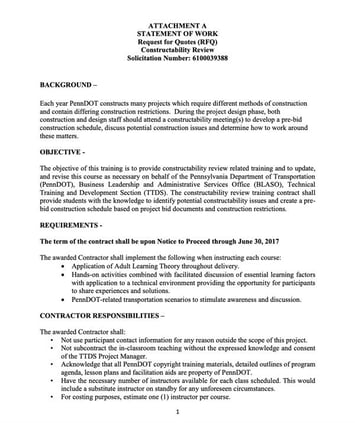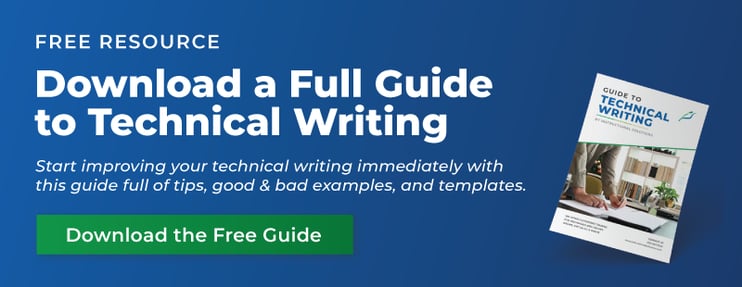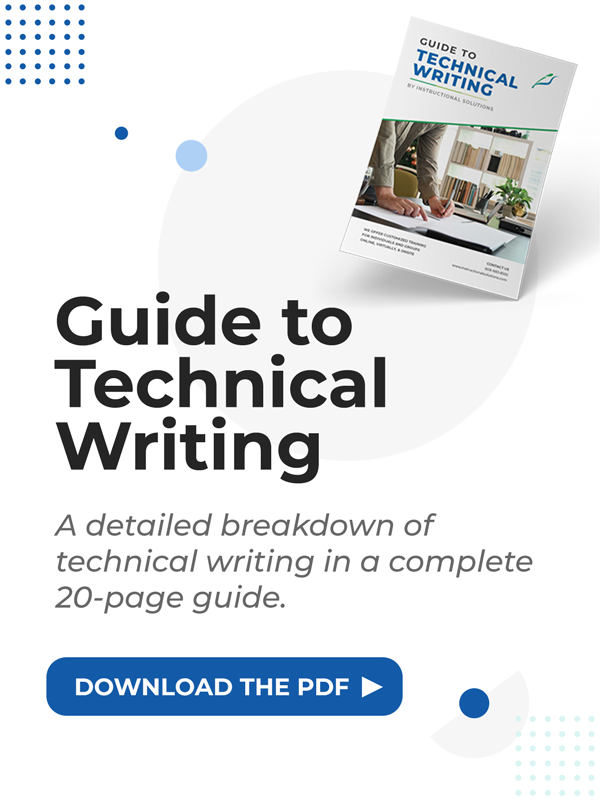How to Write a Statement of Work, With Template and Examples
Originally published March 30, 2023, updated December 4, 2025

Table of Contents
Table of Contents
- What is a Statement of Work (SOW)?
- Key Components of a Statement of Work
- Types of Statements of Work
- Step-by-Step Guide to Writing a Statement of Work
- Tips for Clear and Effective SOW Writing
- Construction Statement of Work Example
- Common Mistakes to Avoid When Writing a Statement of Work
- Final Reminders
- Frequently Asked Questions (FAQs)
- 1. What’s the difference between a Statement of Work and a contract?
A Statement of Work (SOW) is one of the most important documents in project management, across various industries. It serves as a formal agreement between a client and a vendor or supplier, clearly defining the project’s objectives, deliverables, scope, and responsibilities. By laying out expectations in detail, an SOW helps establish alignment from the very beginning, reducing the risk of miscommunication and ensuring smoother collaboration throughout the project. Because of its impact, writing an SOW requires precision, clarity, and a structured approach.
In the following guide, we outline the essential steps for writing a statement of work that supports project success. If you’re also looking to strengthen your overall technical writing skills, our Technical Writing Foundations course can help. The course covers how to draft SOWs as well as other essential technical documents, while also providing instructor feedback to help you improve in practice.
What is a Statement of Work (SOW)?
The statement of work (SOW) represents a promise. The formal document's brevity is part of the reason that clients are so inclined to study it with such precision. An SOW is short and readable. It is not chock full of legalese, but it is a binding agreement.
An SOW accomplishes the following in terms of a project:
- Sets expectations
- Establishes agreed-upon guidelines
- Outlines the entire project scope
- Summarizes what is included in the cost
- Highlights other important points, such as the period of time for completion
It's not the same thing as a scope of work; a scope of work is a section of the SOW that details what is included and what this project will NOT include.
The document is also legally binding, so it's important to have your legal team review it.
Here are the must-follow steps on how to write a Statement of Work (a general SOW) that protects the doer(s) of the job at hand and its project stakeholders.
Key Components of a Statement of Work
- Introduction – The introduction provides context for the project, explaining its purpose and objectives. It sets the stage by describing why the project is being undertaken and what it aims to achieve.
- Scope of Work – This section defines the boundaries of the project, outlining exactly what will and will not be included. It ensures that both the client and vendor understand the extent of their responsibilities and prevents scope creep.
- Deliverables – Deliverables detail the tangible or measurable outputs expected from the project. They should be specific, clearly defined, and tied to criteria for acceptance.
- Timeline – The timeline outlines the project schedule, including key milestones, deadlines, and the overall duration. This helps manage expectations and keeps the project on track.
- Location of Work – This specifies where the work will be carried out, whether onsite, remotely, or across multiple locations. Clarifying this avoids logistical confusion later.
- Additional Elements – Other elements can include payment terms, reporting requirements, roles and responsibilities, and success metrics. These details strengthen accountability and provide a framework for evaluating project success.
Types of Statements of Work
Not all Statements of Work are the same, and choosing the right kind is crucial for project success. The type you select depends on the nature of your project, the level of detail required, and how outcomes will be measured. Each type serves different purposes and is suited to specific industries and project structures. Understanding these distinctions helps you create an SOW that aligns with your project goals and protects all parties involved.
Here are the three main types of Statements of Work:
1. Design/Detail Statement of Work
The Design/Detail SOW is the most comprehensive and prescriptive type of statement of work. It provides explicit instructions on how the work should be performed, breaking down every aspect of the project in granular detail. This type specifies the exact methods, processes, materials, and standards that must be followed throughout the project lifecycle.
This SOW type is commonly used in construction, engineering, manufacturing, and design projects where precision is critical. For example, a construction project might detail the exact materials to be used, building codes to follow, and step-by-step construction processes. The Design/Detail SOW leaves little room for interpretation, ensuring that the vendor or contractor follows a specific approach to achieve the desired outcome.
Key characteristics:
- Highly detailed task descriptions
- Specific methodologies and processes outlined
- Clear technical specifications and standards
- Step-by-step instructions for execution
- Minimal flexibility in approach
2. Level of Effort/Time and Materials SOW
The Level of Effort (LOE) SOW, also known as Time and Materials SOW, focuses on the resources, time, and effort required to complete a project rather than specific deliverables. This type outlines the number of hours to be worked, the expertise level of personnel needed, and the materials or resources that will be utilized.
Payment under this SOW type is typically based on actual hours worked and materials used, rather than fixed-price deliverables. It's ideal for projects where the scope may evolve or isn't fully defined at the outset. Consulting projects, staff augmentation, ongoing maintenance services, and short-term contractor assignments commonly use this format.
Key characteristics:
- Specifies hours of work and resource requirements
- Flexible scope that can adapt as project needs change
- Payment based on time spent and materials consumed
- Less emphasis on specific outcomes
- Suitable for ongoing or evolving projects
3. Performance-Based Statement of Work
The Performance-Based SOW focuses on the desired outcomes and results rather than dictating how the work should be done. It defines what needs to be achieved—the performance objectives, quality standards, and measurable results while giving the vendor or contractor flexibility in determining the best approach to meet those goals.
This type emphasizes accountability for results and encourages innovation and efficiency. The vendor has the freedom to choose methods, processes, and solutions as long as they meet the specified performance criteria. Performance-Based SOWs are popular in IT services, software development, facility management, and government contracts where innovation and cost-effectiveness are valued.
Key Characteristics:
- Defines desired outcomes and performance metrics
- Allows vendor flexibility in execution methods
- Focuses on "what" rather than "how"
- Includes measurable success criteria
- Encourages creative problem-solving
Step-by-Step Guide to Writing a Statement of Work
Step #1: Determine your type of SOW
The three common types of SOWs include:
- Level of Work SOW: This more general SOW maps out the hours of work and resources required for the project. It's appropriate for contractors or short-term projects.
- Design SOW: The design/detail SOW breaks down all project goals and tasks involved with the project. This type is often used by design services and constructions.
- Performance-based SOW: This document breaks down the performance objectives that are expected in a project. It doesn't detail how the project work will be accomplished.
Related: How To Improve Your Technical Writing
Step #2: Think of your audience
Who are you writing this SOW for? Why are you writing it? Answer these questions before you ever begin drafting.
You'll need to research or have conversations with connected parties of the project to determine their needs. Here are potential readers of an SOW and why you might be writing the doc:
- Financial startup requesting website bids
- A government agency with a request for proposals (RFPs)
- Company opens up bidding on building construction projects
An important note here when considering your audience: you want to highlight how you will elevate your client’s organization or department, but do not oversell. You always want to be careful of “scope creep.”
If you have been in the business for a while, you know this all-too-common occurrence. Vendors fall victim to the expectation that additional features or functions are to be included in the project when these have not been authorized. Any requirements not documented in the SOW are deemed beyond the agreed-upon scope. Protect yourself and your company by carefully understanding their needs and what you can reasonably provide.
Step #3: Plan out the sections of the SOW and write
Don't start writing yet. Instead, plan out the content of your SOW.
Although you should customize based on your reader, here are the basic sections of a Statement of Work:
- Background/introduction: The introduction to the SOW should be a brief statement. It should, in the most basic of terms, explain the goal of the project.
- Project objectives: Present project objectives or your purpose statement. Why is the project happening?
- Project scope: Outline what the project outcome will be. Explain, at a high-level, what processes will be included. Wait to include detailed tasks until the next section.
- Tasks and deliverables: This is a list of the detailed activities and deliverables that are expected to be completed by the contractor or vendor. Include the actual tasks.
- Resources and testing: List the materials (e.g., software) needed to make the project successful. Also include the project manager and project teams required by your company and the client's (and the level of effort).
- Project timeline: Provide a deadline for each project deliverable and project milestones. Be realistic and detailed about the project lifecycle. Include specs like quantity, quality, and time. And don’t forget to include contingencies in your plan.
- Payment terms: Detail how you will be compensated and when. It may be based on milestones achieved, hours worked, or a set schedule. Make sure there is no room for misinterpretation of project costs and project budget.
- Special technical requirements: This section is for miscellaneous information or project requirements not included in the rest of the SOW, such as travel requirements or industry-specific standards.
- Acceptance criteria/signatures: Detail how the client will accept project deliverables. Schedule review times for the work delivered. Include a section where the appropriate parties can sign the SOW.
Once you have all these details planned, write out your statement of work.
Become a strong technical writer, and advance your career.
Enroll in our online, self-paced course and get detailed feedback on your actual technical writing.
Download the OutlineStep #4: Edit the document
Before sending your SOW to the client, thoroughly edit the content. Here are different elements to review:
- Be thorough but be brief. Think of the reader's needs.
- Write in short, concise sentences.
- Avoid jargon. Use easy-to-understand terms or clarify what certain words mean if you think the reader might not understand.
- Include visuals and charts if they will help illustrate a concept.
- Steer clear of vague wording that could lead to scope creep, such as "etc."
Also, use a grammar check like Grammarly to avoid missing any major grammar or punctuation errors. Mistakes can impact perceived professionalism.
Step #5: Don’t proceed until you receive a signature
As you would be advised in any Contracts 101 class, do not begin the project kickoff until you get the written signature from stakeholders. For enterprise companies, this may take some time. But you should only begin launch upon getting a formal agreement.
Note: A project charter (a short non-legal project overview) is typically completed and submitted after a statement of work.
Tips for Clear and Effective SOW Writing
Strong SOW writing requires precision and clarity. Follow these tips to create documents that guide projects successfully:
- Use plain language – Write in simple, direct terms so every stakeholder understands the content without confusion.
- Avoid jargon – Replace technical buzzwords with clear explanations that anyone can follow, regardless of background.
- Be specific and measurable – Define deliverables, timelines, and success criteria in quantifiable terms to remove ambiguity.
- Align with business goals – Connect the project scope and outcomes directly to organizational objectives to ensure relevance and value
Construction Statement of Work Example
Need some inspiration as you're writing your project plan? Here is an SOW document by PennDOT in response to an RFQ:
 [Source]
[Source]
Notice the use of headings, bullets, and white space. This formatting makes it easy for the reader to absorb the information.
Hint: You can also use the above example as an SOW template.
Common Mistakes to Avoid When Writing a Statement of Work
Writing a statement of work requires accuracy and balance. Avoid these common mistakes to keep the document compelling and actionable:
- Being too vague or overly detailed: Vague descriptions confuse, while excessive detail overwhelms stakeholders. Strike a balance by focusing on clarity and relevance.
- Skipping stakeholder input: Excluding stakeholders during drafting often leads to misaligned expectations. Engage all relevant parties to ensure agreement from the start.
- Not aligning with the overall contract: A well-written SOW must stay consistent with the main contract. Misalignment creates legal and operational conflicts that slow progress.
- Forgetting to define success metrics: Without measurable criteria for success, project evaluation becomes subjective. Define clear benchmarks to track progress and confirm completion.
Final Reminders
One final, important reminder when writing a Statement of Work is to be inclusive and involve all relevant stakeholders. By encouraging collaboration and gathering input from every party, your SOW transforms into a solid project plan that includes requirements, measurable goals, and contingency strategies. An effective Statement of Work sets you up for a successful project outcome.
Want to improve your skills as a technical writer? Check out our technical writing courses to ensure project success.
Master Technical Writing with Confidence
Refine your writing with expert insights, practical exercises, and guidance to produce precise, effective technical documents.
Frequently Asked Questions (FAQs)
1. What’s the difference between a Statement of Work and a contract?
A contract is a legally binding agreement between parties outlining rights, responsibilities, and obligations, often including payment terms, legal clauses, and dispute resolution mechanisms. A Statement of Work, on the other hand, is a detailed document that defines specific project deliverables, timelines, scope, and requirements. While an SOW can be part of a contract, it focuses more on the execution details of a project rather than the overall legal agreement. Essentially, the contract says we agree to work together, while the SOW says here’s exactly what work will be done and how.
2. Can I use a template to write a Statement of Work?
Yes, using a template for a Statement of Work is common and can help ensure you include all essential sections, such as project objectives, scope, deliverables, timelines, milestones, and acceptance criteria. Templates provide a structured starting point, but they must be customized to fit the specific project, client, and industry requirements. Relying solely on a generic template without adjustments can leave critical details vague or incomplete.
3. When should a Statement of Work be created?
A Statement of Work should be created before a project begins, ideally during the planning or proposal stage. This ensures all parties have a clear understanding of expectations, deliverables, and responsibilities from the outset. Creating it too late can lead to misunderstandings, scope creep, or disputes. It serves as a roadmap for project execution and a reference point if conflicts arise during the project.
4. How long should a Statement of Work be?
There’s no strict rule for length, but a Statement of Work should be long enough to clearly cover all critical project details without being unnecessarily verbose. Typically, SOWs range from 3 to 15 pages, depending on project complexity. Small projects may only need a concise 2–3 page document, while large, multi-phase projects often require a longer SOW with detailed deliverables, schedules, and roles. Clarity is more important than length.
5. Can I change the Statement of Work after the project starts?
Yes, you can definitely modify an SOW, but changes should be documented formally and agreed upon by all parties. This is done through a change request or amendment to prevent disputes and ensure that expectations, timelines, and costs are updated. Uncontrolled or undocumented changes can cause confusion, scope creep, or legal issues, so every modification must be handled carefully and transparently.
6. What happens if the Statement of Work is unclear?
If the SOW is unclear, it can lead to misunderstandings, missed deadlines, disputes, or additional costs. Team members may interpret tasks differently, clients may have unmet expectations, and accountability becomes difficult. In worst-case scenarios, unclear SOWs can result in contract disputes or project failure. A well-written, precise SOW reduces ambiguity and serves as a definitive guide for project execution.



